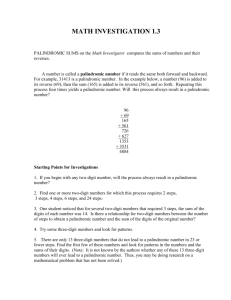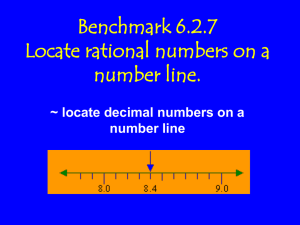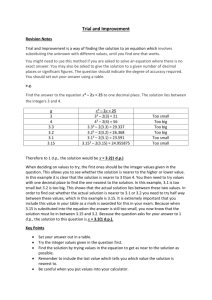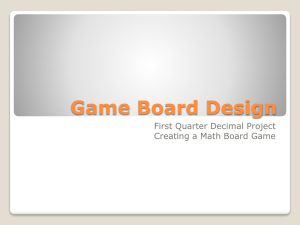MA102D Investigation “Palindromic Decimals”
advertisement
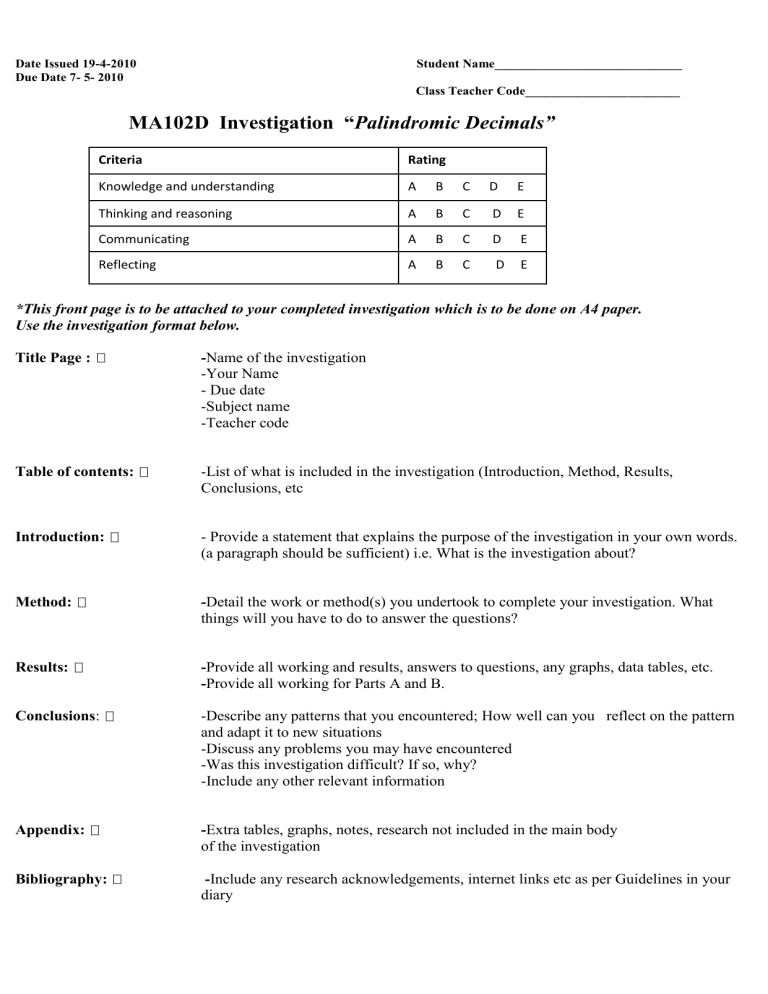
Date Issued 19-4-2010 Due Date 7- 5- 2010 Student Name_____________________________ Class Teacher Code________________________ MA102D Investigation “Palindromic Decimals” Criteria Rating Knowledge and understanding A B C D E Thinking and reasoning A B C D E Communicating A B C D E Reflecting A B C D E *This front page is to be attached to your completed investigation which is to be done on A4 paper. Use the investigation format below. Title Page : -Name of the investigation -Your Name - Due date -Subject name -Teacher code Table of contents: -List of what is included in the investigation (Introduction, Method, Results, Conclusions, etc Introduction: - Provide a statement that explains the purpose of the investigation in your own words. (a paragraph should be sufficient) i.e. What is the investigation about? Method: -Detail the work or method(s) you undertook to complete your investigation. What things will you have to do to answer the questions? Results: -Provide all working and results, answers to questions, any graphs, data tables, etc. -Provide all working for Parts A and B. Conclusions: -Describe any patterns that you encountered; How well can you reflect on the pattern and adapt it to new situations -Discuss any problems you may have encountered -Was this investigation difficult? If so, why? -Include any other relevant information Appendix: -Extra tables, graphs, notes, research not included in the main body of the investigation Bibliography: -Include any research acknowledgements, internet links etc as per Guidelines in your diary Part A Knowledge and Understanding (10 marks) Palindromic numbers read the same forwards and backwards. For example 121, 23532 and 6776 are all palindromic numbers. Q1. List four different palindromic numbers. (1 mark) Q2. What is the next palindromic number after 1331? (1/2 mark) Q3. How many different 5-digit palindromic numbers can be made using the digits 2, 5, 3, 5 and 3? (2 marks) Palindromic decimals read the same from left to right and right to left. For example, 75.57 is a palindromic decimal whereas 6.96 and 722.7 are not. [Note that the decimal needs to be in the centre] Q4. Make a palindromic decimal with the digits 8, 8, 6 and 6. (1/2 mark) Q5. List all possible palindromic decimals by using the digits 3,3,7,7,9 and 9. (1 mark) Q6. Is it possible to have a 5 digit palindromic decimal? Why or why not? (1 mark) Start with the decimal 6.84; then add its reversal (48.6) to obtain a new decimal. Check to see if the new decimal is a palindromic decimal. If not, continue the process until a palindromic decimal is obtained. How many steps are required until a palindromic decimal is obtained? 6.84 +48.6 55.44 +44.55 99.99 1 step 2 steps are required. Q7. How many steps are required to produce a palindromic decimal starting with 3.52? (2 marks) Q8 How many steps are required to produce a palindromic decimal starting with 45.3? (2 marks) Part B Thinking and Reasoning + Reflecting (15 marks) Q1. How many steps are required to produce a palindromic decimal starting with 9.7? Q2. How many different decimals of the form x.y are possible? (e.g. 3.4, 4.3, 5.6, 6.9,etc) List all of these decimals. (1 mark) (3marks) Q3. Investigate whether or not all decimals of the form x.y (e.g. 3.4, 7.8, 9.2 etc) will lead to palindromic decimals when their reversals are added. Include the number of steps required for each decimal. (3 marks) Q4. Present your results in a table with the categories 1-step, 2-steps, 3-steps, etc. List the decimals for each category. Which category has the most? (1-step, 2-steps, etc ) Which category has the least? (3 marks) Q5. Look at the sum of the digits for a decimal of the form x.y. For example 3.4 has a sum of 7; likewise 2.8 has a sum of 10. Describe how the sum of the digits (x + y) relates to the number of steps required to turn a decimal into a palindromic decimal. Include all possible sums of (x + y) (5 marks) Marking Scheme Part A (10 marks) Q1. Four different palindromic numbers (1 mark) Q2. 1441 (1/2 mark) Q3. 35253, 53235 (2 marks) Q4. 68.86 or 86.68 (1/2 mark) Q5. 379.973, 397.793, 739.937, 793.397, 937.739, 973.379 (1 mark if all 6 are listed) Q6. No it is not possible since the decimal needs to be in the middle. The decimal will only be in the middle if there is an even number of digits. (1 mark) Q7. 3.52 +25.3 28.82 one step (2 marks) Q8. 45.3 +3.54 48.84 one step (2 marks) Part B (15 marks) Q1. 9.7 +7.9 17.6 +6.71 24.31 +13.42 37.73 3 steps (1 mark) Q2. Including 0 - 9, there are 90 decimals of the form x.y. [10 x 10 – 10 = 90] Not including 0, there are 72 decimals of the form x.y [9 x 9 – 9 = 72] (1 mark) 0.1, 0.2, 0.3, 0.4, 0.5, 0.6, 0.7, 0.8, 0.9 1.0, 1.2, 1.3, 1.4, 1.5, 1.6, 1.7, 1.8. 1.9 2.0, 2.1, 2.3, 2.4, 2.5, 2.6, 2.7, 2.8, 2.9 3.0, 3.1, 3.2, 3.4, 3.5, 3.6, 3.7, 3.8, 3.9 4.0, 4.1, 4.2, 4.3, 4.5, 4.6, 4.7, 4.8, 4.9 5.0, 5.1, 5.2, 5.3, 5.4, 5.6, 5.7, 5.8, 5.9 6.0, 6.1, 6.2, 6.3, 6.4, 6.5, 6.7, 6.8, 6.9 7.0, 7.1, 7.2, 7.3, 7.4, 7.5, 7.6, 7.8, 7.9 8.0, 8.1, 8.2, 8.3, 8.4, 8.5, 8.6, 8.7, 8.9 9.0, 9.1, 9.2, 9.3, 9.4, 9.5, 9.6, 9.7, 9.8 + (2 marks) for listing them Q3. All of the above decimals will lead to palindromic decimals when added o their reversals. Students need to investigate 45 sums (including 0) or 36 sums (not including 0) (3 marks) Q4. 1-step 7.2, 3.6, 4.5, 8.1, 0.9, 0.8, 1.7, 2.6, 3.5, 0.7, 6.1, 5.2, 3.4, 0.6, 5.1, 2.4, 0.5, 4.1, 3.2, 0.4, 3.1, 0.3, 2.1, 0.2, 0.1 + their reversals (2 marks for table) 2-steps 9.1, 2.8, 7.3, 4.6, 9.2, 3.8, 4.7, 5.6, 9.3, 8.4, 7.5, 9.4, 8.5, 7.6, 9.5, 8.6 + their reversals 3-steps 9.7, 8.7, 9.6 4-steps 9.8 + their reversals + its reversal 1-step have the most, 4-step have the least (1 mark) Q5. Possible sums range from 1 (0.1) to 17 (9.8). (1 mark) 1 step if the digits when added are ≤ 9. 2 steps if the digits when added are between 10 and 14 inclusive. 3 steps if the digits when added are either 15 or 16. 4 steps if the digits when added total 17. (1 mark) (1 mark) (1 mark) (1 mark) Criteria Rating Knowledge and understanding A 9-10 marks Part A Thinking and reasoning A B C D 9-10 7-8.5 5-6.5 3-4.5 This is determined from Part B questions 1 – 4. Communicating A has all 4 below B 7 -8.5 B has any 3 C 5 – 6.5 C has any 2 D 3-4.5 D has any 1 E 3 E 3 E none -has adhered to the report format -accurate and appropriate use of mathematical terminology -information displayed in appropriate format; eg decimals listed systematically or in ascending order, table has headings 1-step, 2steps, 3-steps, etc -generally has accurately communicated and analysed information contained in the table Reflecting A B C 4-5 3 2 This is determined from Part B question 5 D 1 E 0




